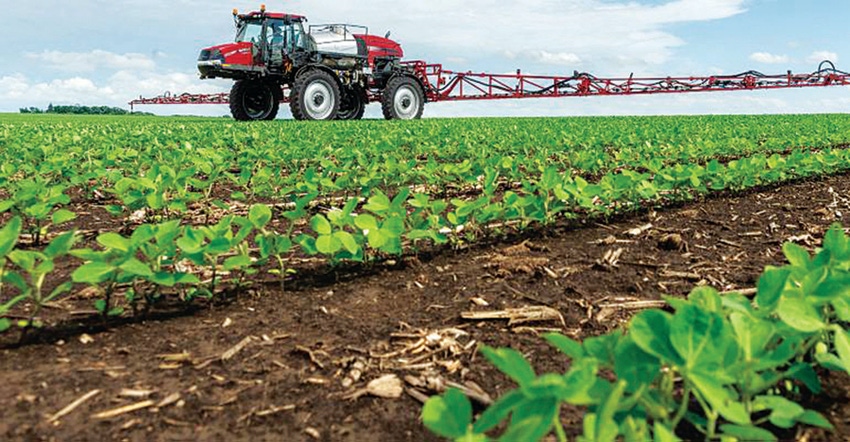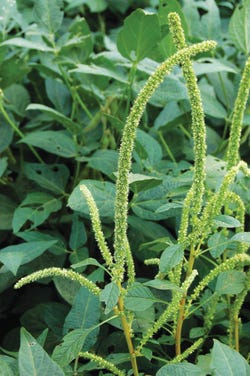October 25, 2018

Whether it’s corn, soybeans, cotton, or other crops, good weed management is often the determining factor in being able to meet yield projections. By not attacking Palmer amaranth, waterhemp, and other weeds early and often with proper herbicide applications, a good crop can go south in a hurry.
With new technologies available to help combat herbicide-resistant weeds, growers have access to those and a host of herbicides. But without following a detailed weed management plan, there’s no guarantee that runaway Palmer amaranth won’t take over, says Dr. Jason Bond, Mississippi State University weed scientist.
“Unfortunately, some growers make mistakes in their weed control and management program,” he says. “Along with yields, their crop production budgets can take a hit.”
Bond tackles weed control problems daily. From his observations, he lists the five biggest mistakes farmers make in their weed control efforts:
Not having a weed management plan in the spring — “It gets down to reacting to whatever happens in weed control, rather than at least planning to control the things within their power,” Bond says. “That type of program usually doesn’t work.”
Poor herbicide timing — “Too many times, growers treat weeds when they’re too large,” he says. “If you treat Palmer amaranth or other resistant weeds that are over 4 inches tall, you’ll probably never catch up. Timing is critical.”
Underestimating how aggressive the growth rate is for some species like Palmer amaranth — “Again, weeds can get out of control very quickly,” Bond says. “It gets back to those timely herbicide applications.”
Not planning crop logistics on your farm, and/or at least communicating with neighbors about herbicide technologies used — “For example,” Bond says, “we inevitably end up with rice that’s susceptible to glyphosate damage being surrounded by Roundup Ready soybeans, or non-Xtend soybeans that are susceptible to dicamba, planted close to Xtend soybeans.”
Trying to mix too many products in spray tank at once — “When too many products are tank mixed, you usually can’t expect each one to work at optimum level,” Bond says.

Don’t forget about weed escapes. Each pigweed plant can produce thousands of seeds that can contaminate fields the following year.
Resistant weeds keep growing in numbers every year. Mississippi State University guidelines for weed control list these weeds as having resistance to various forms of herbicides. Many would also apply to other Mid-South production areas. They include barnyardgrass/junglerice, common cocklebur, common ragweed, goosegrass, horseweed (or marestail), Italian ryegrass, johnsongrass, Palmer amaranth, spiny amaranth, and tall waterhemp.
Bond says using these weed management practices can help control Palmer amaranth:
Use residual herbicides.
Practice crop rotation.
Rotate herbicides with different modes of action.
Tank-mix herbicides with different modes of action at full recommended rates.
Avoid sequential applications of the same herbicide continually.
Utilize tillage, cultivation, and other cultural practices wherever and whenever feasible.
Clean equipment thoroughly before and after each use.
Control weeds post-harvest to reduce weed seed left in the soil.
Off-target herbicide application has been a key problem for some production areas. That’s where it’s vital to make sure herbicides are applied according to label guidelines for wind speed, temperature, and temperature inversion. And it’s essential to use the proper nozzles needed for the newer herbicide technologies.
There have also been numerous situations in which growers sustained “self-inflicted wounds” by not properly cleaning out spray tanks from one mix to another. Bond says growers should clean tanks after the final application of a pesticide and before the application of another pesticide. “Failure to clean the spray tank can result in severe crop injury, or illegal residues in the harvested commodity.”
MSU guidelines say pesticide residues can be cleaned from the spray tank by using commercial tank cleaners. Use clean water to rinse the inside of the spray tank. Use enough water to flush the spray boom hoses and spray tips.
If possible, Bond says, it’s best not to use the same spraying equipment for applying different phenoxy herbicides, such as 2,4-D and dicamba. Herbicides such as 2, 4-D can be satisfactorily cleaned out of sprayers, “but some risk still exists when spraying sensitive broadleaf crops.”
For the most part, he says, growers have tried to follow guidelines in their herbicide programs. “With the herbicides used in the Xtend and Enlist systems, there are a lot of things to check off on in order for the herbicide application to go well. For 2018, temperature inversion apparently was a problem. We had a lot of calm weather in contrast to years past, so we feel that’s what caused some off-target drift issues.”
He stresses that preplant herbicide treatments are the key in getting a good start with weed control. “Preplant or preemergence treatments are non-negotiable,” he says. “It has to be there. Even if the preemerges hold weed emergence for only a few days, that could be the difference in controlling weeds or not.”
Some fields didn’t get an incorporating rain when preemerges were applied this spring. That’s usually not the case. “In late April and early May, chances are good you will get an incorporating rain at the right time,” Bond says. “The law of averages is on your side.”
About the Author(s)
You May Also Like




